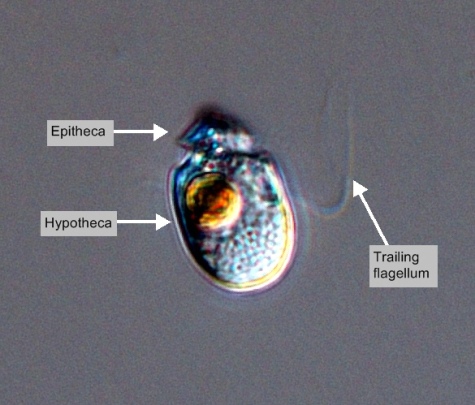



|
Synonym(s)
Amphidinium klebsii 1937
(Kraberg et al. 2010)
Classification
(Guiry and Guiry 2012)
Lifestyle
Photosynthesis
The chemical process by which light energy, water and carbon dioxide are combined to produce oxygen and organic compounds. Photoautotrophic organisms (plants and algae) use this reaction to produce their own food.
photosynthetic dinoflagellate (Kraberg et al. 2010). It reproduces both sexually and asexually (Hansen et al. 2011).Description
Dorsal
Relating to the back portion of the cell; opposite to the ventral side.
dorso- CloseVentral
Relating to the underside of an organism; abdominal.
ventrally compressed body (Montagnes 2006). It is an athecate species and the CloseEpicone
In naked dinoflagellates, the anterior part of a dinokont cell above the cingulum. The equivalent of an epitheca for thecate dinoflagellates.
epicone is crescent or tongue shaped in ventral view (Baig et al. 2006). The cell has one large peripherally placed chloroplast with a centrally located ClosePyrenoid
Any of various protein granules that can be found in the chloroplast of some algae species. It is associated with the production of starch.
pyrenoid (Montagnes 2006). The cell CloseNucleus
(plural: nuclei) In eukaryotic cells, a membrane-bound organelle that contains the cell's genetic information; the nucleus controls the activities of the cell by controlling gene expression.
nucleus is large and is located in the ClosePosterior
The back end of a cell. Opposite of anterior.
posterior part of the cell (Montagnes 2006). Cell CloseCingulum
(dinoflagellates) "In dinokont dinoflagellates, a furrow encircling the cell one or many times" (Horner 2002). It is also known as the girdle or transverse groove and may be located at, above, or below the midpoint of the cell with the left and right ends meeting or displaced form one another (Horner 2002). In diatoms, this term describes the collective elements of a diatom girdle: "The cingulum is made up of delicate silica bands that join the two valves of a frustule. Most diatoms possess a cingulum, although some may not" (Spaulding et al. 2010).
cingulum surrounds the epicone and has a v-shape in ventral view (Montagnes 2006). The cell epicone has a finger-like projection (hook) (Kraberg et al. 2010).Measurements
Width: 7 - 10 μm
(Kraberg et al. 2010)
Similar species
Harmful effects
Habitat
Benthic
The ecological zone at the bottom of a body of water.
benthic dinoflagellate that occurs in association with brown seaweeds (Baig et al. 2006).Distribution
It is a cosmopolitan species found in tropical and temperate waters (Montagnes 2006).
Present throughout the year in low numbers in British Columbia. It was seen in spring blooms in North Arabia Sea (Baig et al. 2006)
Growth conditions
Environmental Ranges
Temperature range (°C): -1.776 - 8.891
Nitrate (μmol L-1): 1.130 - 7.803
Salinity: 30.358 - 34.847
Oxygen (mL L-1): 6.661 - 8.884
Phosphate (μmol L-1): 0.254 - 0.680
Close
Silicic acid
A general term to describe chemical compounds containing silicon, oxygen and hydrogen with a general formula of [SiOx(OH)4-2x]n. Diatoms polymerize silicic acid into biogenic silica to form their frustules (Azam and Chisholm 1976).
Silicate (μmol L-1): 1.973 - 10.195(EOL 2012)
Bloom characteristics
References
Baig, H. S., Saifullah, S. M. and Dar, A. 2006. Occurrence and toxicity of Amphidinium carterae Hulburt in the North Arabian Sea. Harmful Algae. 5(1): 133 - 140.
Encylopedia of Life (EOL). 2012. Amphidinium carterae Hulburt 1957. http://eol.org/pages/901913/details. Accessed 26 April 2012.
Guiry, M. D. and Guiry, G. M. 2012. Amphidinium carterae Hulburt 1957. http://www.algaebase.org/search/species/detail/?species_id=51374. Accessed 26 April 2012.
Hansen, G., Moestrup, O. and Brandt, S. 2011. Amphidinium carterae Hulburt 1957. http://www.marinespecies.org/aphia.php. Accessed 26 April 2012.
Kraberg, A., Baumann, M. and Durselen, C. D. 2010. Coastal Phytoplankton Photo Guide for Northern European Seas. Verlag Dr. Friedrich Pfeil, Munchen, Germany. 203.
Montagnes, D. 2006. Guide to Harmful Phytoplankton. http://www.liv.ac.uk/hab/Data%20sheets/a_cart/a_cart.pdf. Accessed 26 April 2012.
